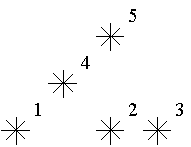Stars
Time Limit: 2000/1000 MS (Java/Others) Memory Limit: 65536/32768 K (Java/Others)Total Submission(s): 9788 Accepted Submission(s): 3920
Problem Description
Astronomers often examine star maps where stars are represented by points on a plane and each star has Cartesian coordinates. Let the level of a star be an amount of the stars that are not higher and not to the right of the given star. Astronomers want to know the distribution of the levels of the stars.

For example, look at the map shown on the figure above. Level of the star number 5 is equal to 3 (it's formed by three stars with a numbers 1, 2 and 4). And the levels of the stars numbered by 2 and 4 are 1. At this map there are only one star of the level 0, two stars of the level 1, one star of the level 2, and one star of the level 3.
You are to write a program that will count the amounts of the stars of each level on a given map.

For example, look at the map shown on the figure above. Level of the star number 5 is equal to 3 (it's formed by three stars with a numbers 1, 2 and 4). And the levels of the stars numbered by 2 and 4 are 1. At this map there are only one star of the level 0, two stars of the level 1, one star of the level 2, and one star of the level 3.
You are to write a program that will count the amounts of the stars of each level on a given map.
Input
The first line of the input file contains a number of stars N (1<=N<=15000). The following N lines describe coordinates of stars (two integers X and Y per line separated by a space, 0<=X,Y<=32000). There can be only one star at one point of the plane. Stars are listed in ascending order of Y coordinate. Stars with equal Y coordinates are listed in ascending order of X coordinate.
Output
The output should contain N lines, one number per line. The first line contains amount of stars of the level 0, the second does amount of stars of the level 1 and so on, the last line contains amount of stars of the level N-1.
Sample Input
5 1 1 5 1 7 1 3 3 5 5
Sample Output
1 2 1 1 0
题意:先按y从小到大输入,若y相同按x从小到大排序;每点的左下角的点的各数就是输出的值;
思路:树状数组的区间求和就是把这一点前面的数給求出来;本题就是按照统计某点的横坐标小于这一点的横坐标x的点的个数;输入数据的顺序就保证了要统计的点是在下方,运用树状数据就进而确定了该点的左方;
代码:
#include<cstring>
#include<cstdio>
#include<algorithm>
using namespace std;
const int N=40000;
int C[N],num[N];
int n;
int lowbit(int k)
{
return k&(-k);
}
int sum(int x)
{
int ret=0;
while(x>0)
{
ret+=C[x];
x-=lowbit(x);
}
return ret;
}
void add(int x,int d)
{
while(x<=N)
{
C[x]+=d;
x+=lowbit(x);
}
}
int main()
{
int x,y;
while(~scanf("%d",&n)){
memset(C,0,sizeof(C));
memset(num,0,sizeof(num));
for(int i=0;i<n;i++)
{
scanf("%d%d",&x,&y);
x+=1;
num[sum(x)]++;
add(x,1);
}
for(int i=0;i<n;i++)
printf("%d\n",num[i]);
}
return 0;
}






















 8192
8192

 被折叠的 条评论
为什么被折叠?
被折叠的 条评论
为什么被折叠?








